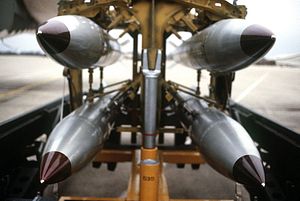It’s strategy document season for the administration of U.S. President Donald Trump. After issuing a National Security Strategy and a National Defence Strategy, the White House has released its long-awaited Nuclear Posture Review.
The document succeeds the 2010 review by the administration of Barack Obama and is an ambitious departure from the status quo in U.S. nuclear thinking.
In addition to calling for two new nuclear capabilities – a sea-launched cruise missile and a lower-yield warhead for existing submarine-launched ballistic missiles – the review expands the conditions under which the United States would use nuclear weapons to encompass more non-nuclear attacks, including cyberattacks and attacks on nuclear command and control.
As with all U.S. reviews of this kind, the document thinks mainly in terms of Russia, the only near-peer nuclear power for the United States. The other two nuclear weapon states in a competitive and adversarial relationship with the United States – China and North Korea – both have far fewer nuclear weapons than the US.
But China has come a long way as a nuclear power and the review notes that Beijing is “modernising and expanding its already considerable nuclear forces”.
These include “entirely new nuclear capabilities”– presumably everything from advanced cruise missiles to hypersonic boost-glide vehicles and a new long-range submarine-launched ballistic missile. The review says that despite this build-up, China has shown “no transparency into its intentions”.
While that lack of transparency may be well-placed, the Trump administration makes little attempt to show that it recognises known Chinese thinking on nuclear weapons. For instance, in underlining China’s determination to reclaim territory in the East and South China seas, the administration projects revisionist intent onto Chinese nuclear strategy.
The review notes, for instance, that while “China’s declaratory policy and doctrine have not changed”, the rapid scope of modernisation raises question about “future intent”.
Whatever we don’t know about China’s nuclear capabilities and debates within the country, the fact remains that Beijing’s observable nuclear posture remains wholly positioned around assured retaliation – China seeks to field a nuclear force that could survive a first strike and retaliate against any of its prospective nuclear aggressors, deterring would-be attackers in the process.
While Western analysts are closely watching debates within China on the merits of it retaining its traditional “no first-use” nuclear posture, there’s little evidence that China’s leadership will adopt an explicit first-use posture any time soon.
Even as China pursues salami tactics in the East and South China seas and modernises its conventional and nuclear forces, its thinking about the role of nuclear weapons in statecraft limits their role to deterrence.
To be sure, the United States should rightfully concern itself with Chinese investments in advanced systems for theatre-wide nuclear strike capability. Beijing’s pursuit of multiple independently targetable re-entry vehicles, precision hypersonic boost-glide missiles like the DF-17, antisatellite weapons, and a range of dual-capable medium- and intermediate-range missiles puts U.S. installations and aircraft carriers in East Asia at risk.
As the review notes, if China’s overarching goal is to deny the U.S. military room for manoeuvre in East Asia, the modernisation of its nuclear forces supports that objective. The review ultimately presents little in the way of original thinking about how the U.S. can better understand Chinese intentions and work towards reining in China’s pursuit of advanced nuclear delivery methods, such as through bilateral arms control.
The 2018 review will ultimately change little in the way China perceives nuclear threats from the United States. Instead, the document will vindicate China’s existing pursuit of vertical and horizontal force modernisation.
This article originally appeared in the South China Morning Post. It is republished here with kind permission.

































